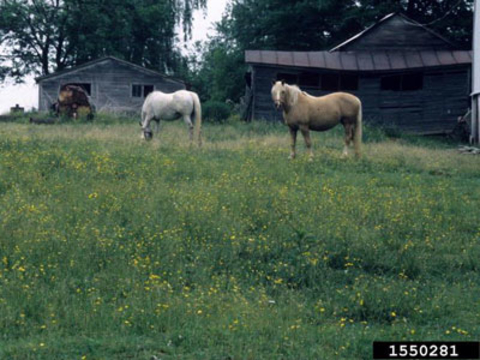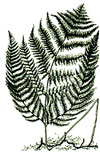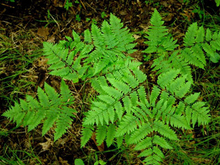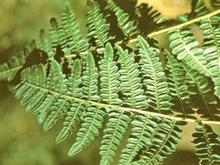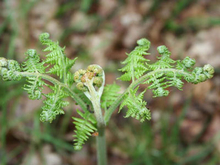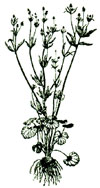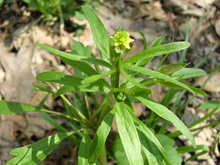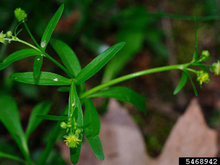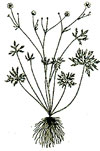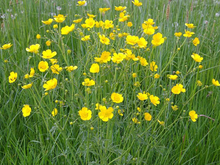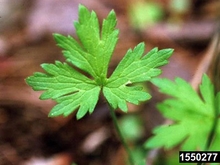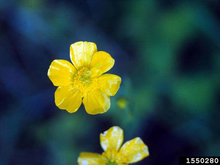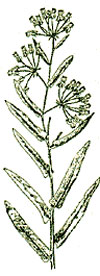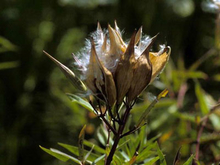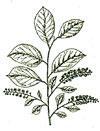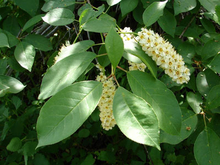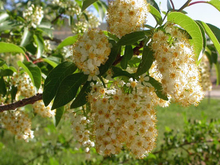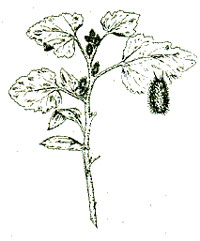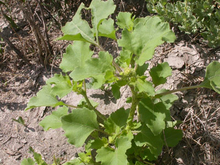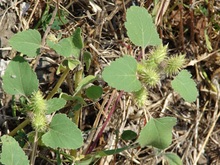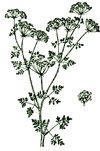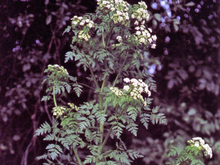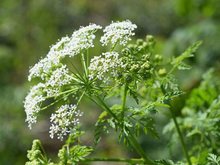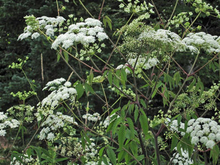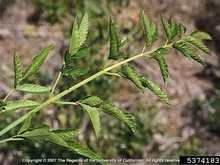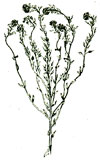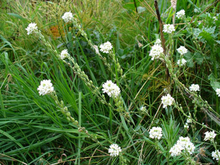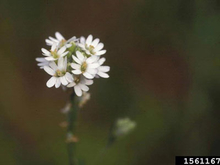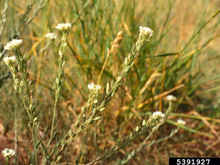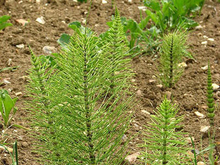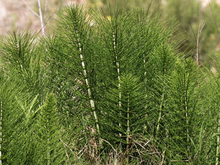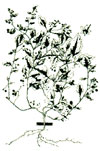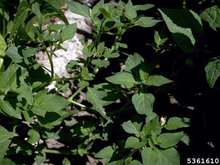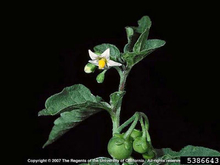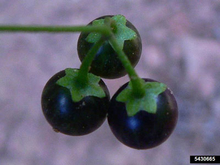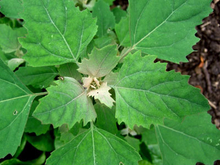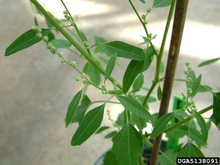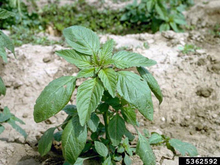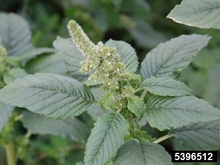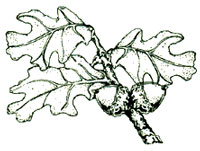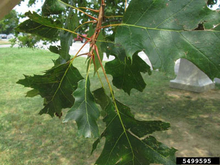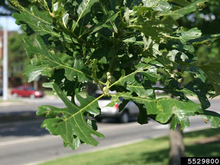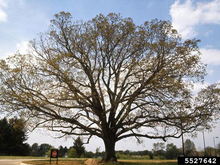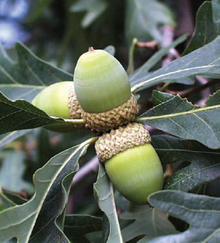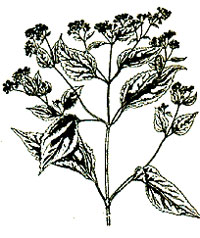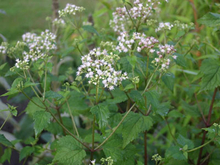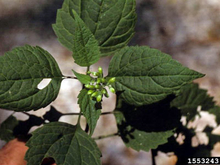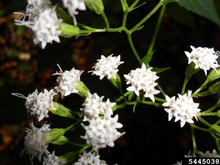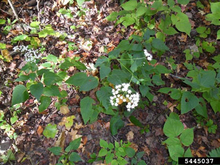Recognizing poisonous plants and properly managing animals and pastures will help minimize the potential of poisoning animals. When an animal goes off feed, loses weight or appears unhealthy, poisonous plants may be the cause.
Poisonous plants contain toxic compounds that can injure animals. Some contain compounds that can kill, even in small doses. Others contain substances that reduce performance, such as weight loss, weakness and rapid pulse.
Signs of poisoning
Consider poisonous plants as the potential cause, especially if the following situations exist:
- Pasture forage supply is sparse due to overgrazing, drought or poor early-season growth.
- Animals recently moved into a new pasture.
- Animals have been released into a new pasture when hungry.
- Herbicides have been used to control weeds.
- Pasture has recently been fertilized with nitrogen.
- A new forage source has been fed.
Most poisonings occur in the early spring or during a drought when feed is short. Plants an animal normally wouldn’t touch become a potential source of food and a potential source for poisoning, just because the animal is hungry and searching for food.
Also, some herbicides may increase the palatability of some weeds. This is why it’s important to read the herbicide label and follow all grazing restrictions. Also, if there are poisonous plants in the pasture, it’s best to keep all livestock out until the plants have died.
Poisoning in different livestock
Poisoning in cattle
In Minnesota, nitrate poisoning is the number one cause of poisoning in cattle. Nitrates accumulate in certain plants when grown under drought stress or they’ve been fertilized with nitrogen.
Causes
Much of the nitrate poisoning is caused by the crops sorghum-sudangrass and corn, and the weeds redroot pigweed and common lambsquarters. Sorghum-sudangrass hybrids have been the number one cause of nitrate poisoning in Minnesota.
Other main causes for cattle poisoning in Minnesota rank as follows:
- Gallotannins in oak species, mainly in southeastern Minnesota.
- Cyanide poisoning caused by sorghum species and chokecherry plants.
- Glycoside poisoning from nightshades and cocklebur.
- Photosensitive skin reactions from St. Johnswort and buckwheat.
- Cicutoxin poisoning from water hemlock.
- Alkaloid poisoning from poison hemlock.
Poisoning in sheep
The top two causes of plant poisonings in sheep in Minnesota have been nitrates poisoning and photosensitive reactions.
Poisoning in horses
In horses, wilted maple tree leaves are the number one poisoning problem.
Hoary alyssum and white snakeroot are the next highest-ranking plants in terms of poisoning horses. When hoary alyssum is more than 30 percent of the feed source, it’s been linked to stocking up (swelling of the lower legs) and other problems in horses. White snakeroot has caused death.
Other less common plants causing livestock poisonings are water hemlock, poison hemlock, brackenfern and the nightshades.
Strategies for preventing poisoning
Identify poisonous plants
The key to avoiding problems with poisonous plants is to properly identify these plants and avoid them. Become familiar with the plants that can cause problems. Examine pastures, hay fields, roadsides and fence rows for poisonous plants.
In a drought year or a year when feed is short, take extra precautions to look over new areas planned for grazing or haying such as roadsides, wooded areas or sloughs.
When animals have adequate feed, they’ll avoid most poisonous plants. However, when feed is short or animals are hungry, plants normally avoided become a tempting source of feed and a potential poisoning problem.
Manage pastures
Knowing how to correctly identify poisonous plants will help prevent potential problems and perhaps an animal’s death. Other management tips to avoid problems include:
- Avoid overgrazing pastures.
- Avoid turning hungry animals into new pastures.
- Learn to identify poisonous plants.
- Fence off areas in pastures where poisonous plants occur.
- Control or manage plants to avoid poisoning problems.
- Follow herbicide grazing restrictions.
- Rotate pastures to prevent overgrazing.
- Supply adequate supplies of clean, fresh water for livestock.
- Consult your veterinarian to correctly identify a suspected poisoning from plants, to prevent it from happening in the future.
Poisonous plants
The following are descriptions of many of the poisonous plants in Minnesota. We’ll describe what they look like, where they grow, their poisonous parts and when they’re most poisonous. In addition, you’ll find information about poisoning symptoms and some of the plant’s toxic compounds.
(Pteridium acquilinum)
Plant characteristics
Brackenfern is a perennial that reproduces by spores and thick, scaly underground rhizomes. It’s usually found growing in colonies. On established plants, leaves (fronds) arise directly from the rhizomes and reach heights of 1 to 4 feet.
The leaf is three-parted, or branched, and each leaf is composed of many tiny leaflets. The three-parted leaf is a characteristic that distinguishes it from other ferns. Spores are borne on the underside of each leaflet in a narrow band on the leaf margins.
Poisoning overview
- Conditions conducive to poisoning: All season and when dried in hay.
- Plant habitat: Dry, poor soil, open woods, pastures and sandy ridges. Found in the northern half of Minnesota.
- Affected animals: All grazing animals.
Symptoms of poisoning
Cattle:
- Accumulative poisoning over at least one month.
- Clots of blood in feces, swelling of throat region in young animals.
- Causes aplastic anemia.
- Unthriftiness, weight loss and weakness.
Horses:
- Loss of appetite and “star-gazing” Vitamin B1 deficiency.
Smallflower buttercup
(Ranunculus abortivus)
Plant characteristics
Smallflower buttercup grows as an annual or biennial reproducing by seed. Stems are slender, slightly hairy, branched from the base and reach 6 to 20 inches tall.
Lower leaves are round, palmately veined and bright green, with round-toothed margins. They’re borne on long stems arising from the plant’s base. Upper leaves are borne on shorter stems, alternate and divided into three to five leaflets with somewhat toothed margins.
Flowers are small and yellow, with five to seven oblong petals.
Tall buttercup
(Ranunculus acris)
Plant characteristics
Tall buttercup is a perennial that reproduces by seeds. Stems are erect, hairy and 1 to 3.5 feet tall, branching at the top.
Leaves are alternate, divided into narrow segments and usually three-cleft. Leaves are covered with hairs.
Flowers have five to seven shiny, oblong petals that are bright yellow, but may sometimes be cream-colored. Flower size varies from 1/8 to 1 inch in diameter.
Poisoning overview: Buttercups
- Conditions conducive to poisoning: Early spring and summer. Isn’t toxic when dried in hay.
- Plant habitat: Pastures, meadows, streams and wastelands. Mostly found in the northern half of Minnesota.
- Affected animals: All animals, especially cattle.
Symptoms of poisoning: Buttercups
- Leaves cause skin blistering minutes to a few hours after eating.
- Burning irritation in mouth and throat, followed by increased salivation, redness and blistering of the mouth and throat.
- Swallowing causes abdominal pain, vomiting and diarrhea. Large amounts cause dizziness, delirium, tremors and convulsions.
- May also cause kidney damage, excessive urine production, blood in urine followed by a decrease in urine flow.
- Lactating cattle suffer a drop in milk production. Milk is bitter and red-tinted.
- Sheep may suddenly collapse.
- Pigs may show paralysis.
- Toxin is an acrid yellow oil, protoanemonin, which can be driven off with drying, such as when cured for hay.
(Asclepias tuberosa)
Plant characteristics
Butterfly milkweed is the most poisonous of the plants in the milkweed family. It’s a perennial that reproduces by rootstalks and seeds.
Stems are stout and terminally branched. They’re generally clumped and may reach 2 feet tall. Stems contain a watery juice rather than a milky juice found in other milkweed.
Leaves are lance-shaped with pointed tips. They’re 6 inches long and alternate along the stem.
Flowering occurs from June to September. Flowers are brilliant orange, red or yellow and are arranged in rounded bunches at the top of the plant.
Plants produce one to two spindle-shaped, 3- to 5-inch-long pods, with each containing many seeds. Pods split open in the fall to release the seeds. A silky plume on the top of each seed provides easy wind distribution.
Poisoning overview
- Conditions conducive to poisoning: Spring.
- Plant habitat: Dry open areas, waste places, prairies, abandoned roads and streambeds. Found throughout Minnesota.
- Affected animals: All grazing animals.
Symptoms of poisoning
- Loss of muscle control, spasms, bloating, increased pulse rate, weak rapid breathing, fever, coma and death.
- Symptoms occur within one to two days after eating.
- Toxin is a resinoid, galitoxin. Plants also contain glucosides and alkaloids.
(Prunus virginiana)
Plant characteristics
Chokecherry grows as a large shrub or small tree from 4 to 25 feet tall. The bark is gray to brown, and is smooth to somewhat scaly.
Leaves are alternate, ovate-shaped, 1 to 3 inches long, 1.5 inches wide and sharply toothed.
Flowers are white or pink, produced in clusters 2 to 3 inches long. Fruits are like small cherries, red at first, turning purple to black at maturity. Twigs give off a strong odor when crushed.
Poisoning overview
- Conditions conducive to poisoning: Leaves, bark and seeds poisonous during all seasons.
- Plant habitat: Along streams and open forests, waste areas, fence rows, woods, prairies, orchards and dry slopes. Found throughout Minnesota.
- Affected animals: All grazing animals.
Symptoms of poisoning
- Slobbering, muscle tremors, increased respiration rate, rapid and weak pulse, convulsions, labored breathing, abdominal pain, depression, paralysis, coma and death.
- Symptoms noticed in 30 minutes to one hour.
- Caused by glycoside amygdalin which, upon hydrolysis, yields hydrogen cyanide (HCN).
(Xanthium strumarium)
Plant characteristics
Cocklebur is an annual plant reproducing only by seeds. The root is a taproot, woody and stout.
Stems are hairy, rough to touch, erect and reach 2 to 4 feet tall. Stems are branched and frequently spotted with red.
Leaves have an alternate arrangement, attach to stems by long stems, are simple and vary from heart-shaped to kidney-shaped. The leaf surface is hairy and rough to the touch.
Flowers are small and green, borne together in clusters in the axils of the upper leaves. Fruit is a two-seeded bur that’s hard, woody and covered with hooked spines.
Cocklebur seedlings have long, narrow cotyledons that taper to a point at the tip. Seedlings tend to be triple-veined at the base, reach a length of about 3 inches, are sessile and covered with rough hairs.
The first leaves are triple-veined at the base, covered with rough hairs, and prominently veined. While the first leaves have an opposite arrangement, later emerging leaves are alternate.
Poisoning overview
- Conditions conducive to poisoning: Spring as seedlings, especially in the 2-leaf (cotyledon) stage.
- Plant habitat: Lowlands, barnyards, fields, roadsides, poor pastures, wastelands and exposed shores of lakes, ponds and rivers. Found throughout Minnesota.
- Animals: All animals, especially hogs and cattle.
Symptoms of poisoning
- Loss of appetite, depression, incoordination, twitching and paralysis.
- Seedlings have caused death in pigs.
- Poisoning caused by hydroquinone.
- Symptoms noticed a few hours to two days after eating.
- Death may occur in three days.
Poison hemlock
(Conium maculatum)
Plant characteristics
Poison hemlock is a biennial reproducing only by seeds.
A basal rosette forms the first year followed by an erect, flowering stalk the second year. Taproot is fleshy and parsnip-like, with the biennial roots resembling small white carrots.
Stems are erect, hollow between the node and hairless, reaching heights of 2 to 7 feet. The stem is much-branched, slightly grooved and often spotted with purple.
Leaves have an alternate arrangement, and are large, compound with four to five leaflets, finely divided and toothed. They have a lacey appearance, and are smooth and dark green in color. When crushed, leaves give off a parsnip odor.
Flowers are borne in large, terminal, flat-topped to slightly convex umbels. Petals are white and appear from mid-summer through mid-autumn.
Poisoning overview
- Conditions conducive to poisoning: All parts, all season and when dried in hay. Seeds are especially poisonous.
- Plant habitat: Warm sites, stream edges, gardens and wet, disturbed ground like ditches and field edges. Found throughout Minnesota.
- Affected animals: All animals.
Symptoms of poisoning
- Loss of appetite, salivation, bloating, feeble pulse, paralysis and birth defects.
- Temporary stimulation of nervous system, followed by general depression of the nervous system. Similar symptoms as spotted water hemlock, but without convulsions.
- Death is painful because the victim remains conscious.
- Symptoms occur in minutes to a few hours after eating. Death occurs as soon as 15 minutes and up to eight hours after eating.
- Toxin is a group of nicotine-like alkaloids, with the most important being choline.
Spotted water hemlock
(Cicuta maculata)
Plant characteristics
Spotted water hemlock is a perennial reproducing by seeds and tuberous roots.
Fleshy roots arise from a chambered rootstalk. Perennial roots consist of a bundle of several finger-like, white tubers that are easily pulled from the soil.
Stems are erect, 2 to 6 feet tall, branched at the top and hollow inside except at the nodes. Stems are smooth and often mottled with purple, especially at the base. Roots and stems may produce a yellowish oil when cut that’s fragrant and poisonous.
Leaves have an alternate arrangement, are 8 to 12 inches long, compound and smooth with toothed edges. Veins on the leaflets end in the notches. Leaves are divided into three groups of leaflets per leaf. The leaf stalk grasps the stem like a celery bunch.
Crushed leaves and stalks smell like parsnips or parsley, and are sometimes unpleasant. Flowers have five small white petals and are borne in compound terminal umbels with stalks of unequal length.
Poisoning overview
- Conditions conducive to poisoning: All season, and when dried in hay. All parts are poisonous, especially the roots. Roots can poison drinking water.
- Plant habitat: Damp, open habitats, ditches, wet meadows, swamps, lowlands and streams. Found throughout Minnesota.
- Affected animals: All animals, especially swine.
Symptoms of poisoning
- Burning sensation in the mouth a few minutes to a few hours after eating. Difficulty swallowing, foaming at the mouth, excessive salivation and dilation of the pupils.
- Internal symptoms: Nausea, diaphragm contractions, vomiting, diarrhea and violent convulsions.
- Affects the nervous system, resulting in nervousness, muscle twitching, violent teeth clenching, slowing of the heart, weak pulse, visual disturbances, heart failure, loss of consciousness and death.
- Occurs in 15 minutes to one hour.
- Poison is an unsaturated alcohol, cicutoxin. A piece the size of a walnut can kill a cow.
(Berteroa incana)
Plant characteristics
Hoary alyssum can grow as an annual, biennial or short-lived perennial, reproducing by seeds. Stems are gray-green, hairy and 1 to 3 feet tall, with many branches near the top.
Leaves are alternate, oblong, gray-green, covered with rough hairs, and are 1/2 to 3 inches long with smooth edges. Flowers are white with four deeply divided petals. Seed pods are hairy, oblong and swollen with a short beak on the end.
Poisoning overview
- Conditions conducive to poisoning: All seasons and when dried in hay.
- Plant habitat: Meadows, pastures and hay fields’ waste places, particularly on sandy soils. Found throughout Minnesota.
- Affected animals: Horses.
Symptoms of poisoning
- Horses experience depression and “stocking up”, or swelling of the lower legs, 12 to 24 hours after eating.
- A fever and occasional short-term diarrhea may also occur.
- Symptoms normally subside two to four days after feed removal.
- Potential for problems increase when hay or feed contains more than 30 percent hoary alyssum.
- Cattle and sheep may reject feed containing hoary alyssum.
(Equisetum arvense)
Plant characteristics
Horsetail is a perennial reproducing by spores and creeping rhizomes. The rhizomes are attached to tiny underground tubers.
The plant has two forms: Vegetative and reproductive. The vegetative form produces shoots that can reach up to 2 feet tall. The shoots are jointed, and have whorled branches at each joint.
Branches are jointed and look somewhat like a coarse, elongated pine needle. The plant resembles a small evergreen tree.
The reproductive form is a rush-like plant. Shoots are hollow, jointed, branchless and leafless with a toothed sheath at each node. The fruiting heads contain masses of tiny, pale, greenish spores in a pinecone-like structure.
Poisoning overview
- Conditions conducive to poisoning: Spring, summer and when abundant in hay.
- Plant habitat: Damp, wet places, roadsides, fields and waste places. Sandy, gravelly soils. Found throughout Minnesota.
- Affected animals: Sheep, cattle and horses.
Symptoms of poisoning
- Loss of condition, excitability, unthriftiness, staggering gait, rapid pulse, difficult breathing, diarrhea and emaciation.
- Death preceded by convulsions and coma.
- Deceased milk production in cows. Trembling in sheep.
- Poisoning accumulative over one month.
(Solanum species)
Plant characteristics
Nightshades are mostly annuals, reproducing by seed. Stems are erect or spreading, becoming widely branched and growing 1 to 2 feet tall.
Leaves are egg-shaped, 1 to 3 inches long and alternate with wavy edges. Flowers occur in small clusters, and are white, five-lobed and about 1/4 inch across.
Plants produce berry-like fruit. Berries contain numerous seeds and are smooth, 3/8 inch in diameter and green, turning black at maturity.
Poisoning overview
- Conditions conducive to poisoning: Summer and fall. Unripe berries especially poisonous.
- Plant habitat: Crop fields, waste places, fence rows, yards, gardens and open woods. Grows well on loamy or gravelly soils. Found throughout Minnesota.
- Affected animals: All animals.
Symptoms of poisoning
- Weakness, trembling, labored breathing, nausea, constipation or diarrhea, death.
- First symptoms may be paralysis of tongue and dilated pupils.
- Symptoms occur within a few hours or up to one to two days after eating.
- Toxin is glycoalkaloids.
Plant characteristics
Pigweeds and lambsquarters are annual weeds common throughout the United States. They’ll accumulate nitrates when grown under drought stress and high nitrogen fertility.
Grasses such as corn, sorghum and sorghum-sudans will also accumulate nitrates when grown under similar conditions.
Poisoning overview
- Conditions conducive to poisoning: Especially a problem when plants are grown under drought stress and high N fertility.
- Plant habitat: Pigweeds, lambsquarters, corn, sorghums and other grasses.
- Affected animals: All grazing animals.
Symptoms of poisoning
- Increased salivation, labored breathing, incoordination, weak pulse, muscle tremors, vomiting, diarrhea, suffocation and death.
- Symptoms two to six hours after eating.
(Quercus spp.)
Plant characteristics
Oak are perennial shrubs to large deciduous trees. Leaves grow in clusters of two to four leaves at the tips of all twigs.
Most species can cause livestock poisonings. Gamble and shinnery oak are responsible for most livestock poisonings. Bur oak has deeply furrowed bark with deeply lobed, 10-inch-long leaves.
The leaves’ upper surfaces are dark green, while its undersides are silver and hairy. Pin oak, red oak and white oak are also common oak species found in the upper Midwest.
Poisoning overview
- Conditions conducive to poisoning: In the summer and fall. Young oaks and sprouts as well as buds and new leaves of mature trees (declines as leaves mature). Unripe (green) acorns are especially poisonous.
- Plant habitat: In most deciduous woods. Found throughout Minnesota.
- Affected animals: All grazing animals.
Symptoms of poisoning
- Loss of appetite, constipation, dry muzzle and black, pelleted feces followed by diarrhea with blood and mucus.
- Frequent urination and weak, rapid pulse.
- Death may occur a few days to two weeks after symptoms start. Caused by gallotannins.
(Eupatorium rugosum)
White snakeroot is a perennial reproducing by seeds and short rhizomes. Roots are much-branched and fibrous. Stems grow from one to three feet tall and are smooth and erect, branching at the top. Leaves are opposite, three-veined with toothed edges and taper to a pointed end. Flowers are small and white, generally appearing in late August.
Poisoning overview
- Conditions conducive to poisoning: All seasons and when dried with hay.
- Plant habitat: Shaded areas, woods, clearings, hardwood pastures and waste places. Moist and fertile soils. Found throughout Minnesota.
- Affected animals: All grazing animals.
Symptoms of poisoning
- Plant contains tremetone, which causes depression, labored breathing, tremors, nausea and death.
- Milk sickness in cattle.
- Tremetol may be transmitted via milk and butterfat to humans and other animals, causing milk sickness in them.
- Causes trembles in sheep.
- Onset of symptoms noticed two to three days after eating.
Alternate (leaf arrangement): One leaf attached at each stem node.
Annual: A plant that completes its life cycle in one year or less, and only reproduces by seed.
Biennial: A plant that completes its life cycle in two years, and only reproduces by seed.
Compound (leaf type): A leaf divided into two or more distinct leaflets.
Cotyledons: Seed leaves; the first leaf-like structures appearing above the ground in broadleaf plants.
Opposite (leaf arrangement): Leaves attached in pairs at each stem node.
Perennial: A plant that may live for more than two years, and reproduces by seeds, rhizomes or other underground plant parts.
Photosensitization: An increase in sensitivity to sunlight, resulting in sunburned skin when exposed to ultraviolet light.
Rhizome: An underground stem. Found on perennial plants.
Rosette: A basal cluster of leaves, like a dandelion. The first year's growth of biennial plants.
Stocking up: Swelling of any of the lower legs because of interference with circulation or bruising of the tissues.
Whorled (leaf arrangement): A leaf arrangement in which three or more leaves are attached at each stem node.
Bergland, B. & Bolsby, C.E. (1971). The edible wild. Charles Scribner’s & Sons Publishing.
Etkin, N.L. (editor). (1986). Plants in indigenous medicine and diet biobehavioral approaches. New York: Redgrave Publishing Company.
Keeler, R.F., Van Kampen, K.R., & James, L.F. (editors). (1978). Effects of poisonous plants on livestock. New York, London and San Francisco: Academic Press.
Kommedahl, T. & Johnson, H.G. Pesky plants. Minnesota Extension Bulletin, MI-3733.
Levy, C.L. & Primack, R.B. (1984). A field guide to poisonous plants and mushrooms of North America. The Stephen Greene Press.
Marczewski, I.E. (1983). Pasture plants toxic to livestock in Michigan (Bulletin E-1725). Michigan State University Extension.
Morrison, F.B. (1959). Feeds and feeding (22nd ed.). Morrison Publishing Company.
North Central Regional. (1981). Weeds of the north central states (research publication no. 281).
Runkel, S.T. & Roosa, D.M. (1989). Wildflowers of the tallgrass prairie: The Upper Midwest. Iowa State University Press.
Stevens, O.A. & Mitch, L.W. (1977). Plants which may be poisonous (University Circular A-471). North Dakota State.
Stuart, M. (editor). (1982). VNR color dictionary of herbs and herbalism. Van Nostrand Reinhold Company.
U.S. Department of Agriculture. (1958). 16 plants poisonous to livestock in the western states (Farmers Bulletin no. 2106). Washington, D.C.
Reviewed in 2023


